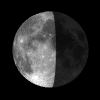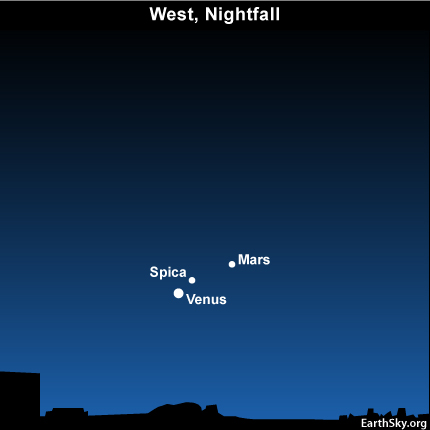Courtesy of EarthSky
A Clear Voice for Science
www.EarthSky.org

 The first few evenings of September 2010 present a celestial trio – the planets Venus and Mars, and the star Spica fitting within a circle that is smaller than 5 degrees in diameter. Because a typical binocular field spans about 5 degrees of sky, there is a good chance of seeing all three luminaries squeezing up together inside a single binocular field.
The first few evenings of September 2010 present a celestial trio – the planets Venus and Mars, and the star Spica fitting within a circle that is smaller than 5 degrees in diameter. Because a typical binocular field spans about 5 degrees of sky, there is a good chance of seeing all three luminaries squeezing up together inside a single binocular field.
All three should be bright enough to see with the unaided eye, if your sky is clear enough. However, do not tarry when looking for tonight’s celestial trio. The threesome – Venus, Mars and Spica – stays out for only a short while after dark. The trio follows the sun beneath the horizon about 1.5 hours after sunset.
Venus is by far the brightest light of the trio. Although Spica ranks as a first-magnitude star, it pales next to the sky’s brightest planet. In addition, sparkling blue-white Spica outshines the red planet Mars.
Watch this celestial trio over the next several evenings, as these two worlds dance around the star Spica. This evening, Venus couples up with Spica. On September 5, look for Spica to pair up with Mars.
Catch the celestial trio about one hour after sunset. Look for Venus first, then for Spica and Mars.
Venus sets as Jupiter rises on September 2010 evenings
Written by Bruce McClure
Astronomy Picture of the Day from NASA/JPL
U.S. Naval Observator Astronomical Information center
